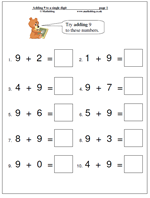 Here are two maths worksheets of practice at adding 9 to a single digit. The obvious method to do this is to add ten and then take away one. However, this method is only efficient if ten is added mentally and not counted on. (Otherwise you might just as well count on 9!) Once again, the aim is for children to become quick and efficient in their heads so that answers are given just as quickly as if they were asked their name.
Here are two maths worksheets of practice at adding 9 to a single digit. The obvious method to do this is to add ten and then take away one. However, this method is only efficient if ten is added mentally and not counted on. (Otherwise you might just as well count on 9!) Once again, the aim is for children to become quick and efficient in their heads so that answers are given just as quickly as if they were asked their name.
Category: Free Worksheets Maths: four rules
Learning tables: 2, 3, 5 and 10 times tables practice
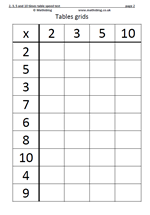 On this maths worksheet is a tables grid for the 2x, 3x, 5x and 10x table.
On this maths worksheet is a tables grid for the 2x, 3x, 5x and 10x table.
The grid is filled in by taking the numbers across the top with the numbers down the side as shown below.
There are many different approaches to this type of problem. Some children fill in the answers in strict order, others go through and complete the ones they know off by heart, and then try to work the rest out.
It is a good idea to set a time limit to these to encourage learning them off by heart.
Free maths worksheet: begin to add decimals
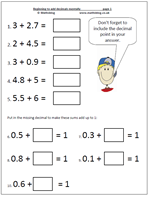 Free maths worksheet from mathsblog.co.uk
Free maths worksheet from mathsblog.co.uk
When it comes to decimals children can become very confused, so here is a nice starter for adding a decimal.
The key to success is to make sure that the units are added to the units, so that 3.4 + 5 is 8.4, not 3.9 and always remember the decimal point in the answer.
Maths worksheet: dividing by 1 and 10
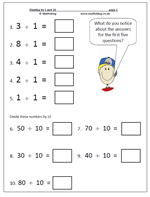 Division is one of the big problem areas in maths, partly because success relies on a good knowledge and understanding of basic number.
Division is one of the big problem areas in maths, partly because success relies on a good knowledge and understanding of basic number.
There are two important ideas about division on this maths worksheet. Firstly, when a number is divided by 1 it stays the same. Fairly obvious to us, but for young children they need to understand division in two ways:
a. understand division as grouping or repeated subtraction. For example: 20 divided by four can be thought of as ‘how many 4s make 20?
8 divided by 1 can be thought of as ‘how many 1s make 8?’
b. understand division as sharing. For example: share 20 sweets between 4 people.
8 divided by 1 can be thought of as sharing 8 between one person ie they get it all!
The second part of this worksheet looks at dividing by 10. Now it has been stressed before that when multiplying by ten we must not say ‘just add a nought’. In the same way when dividing by ten don’t say ‘take away the nought’ because later there will not be any noughts in the questions!
Free maths worksheet: adding 8 to a single digit
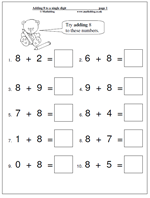 Free maths worksheet from mathsblog.co.uk
Free maths worksheet from mathsblog.co.uk
Here are two straightforward sets of questions which deal with adding 8 to a single digit. Eventually children should know, off by heart, all the answers to these questions, but that takes a lot of time and practice. Confidence can be gained by learning some of them; eg knowing that 8 + 2 makes 10 can lead on to knowing that 8 + 3 makes 11.
Until they have been learnt most children will need to count on, perhaps using fingers or practical apparatus such as cubes to work the answers out.
Learning tables: 9 times table
Learning the 9x table with mathsblog.co.uk
 The 9 times table does have a number of interesting patterns, not least of which is that the digits of each answer also add up to 9. This is an excellent way of checking that a number is divisible by 9.
The 9 times table does have a number of interesting patterns, not least of which is that the digits of each answer also add up to 9. This is an excellent way of checking that a number is divisible by 9.
Once again we are really only interested in the really fast recall that comes with memorising the table.
The whole idea of tables is that they are learnt, off by heart. To do this it is essential to say them out loud:
One times nine is nine
two times nine is eighteen
three times nine is twenty seven
four times nine is thirty six
five times nine is forty five
six times nine is fifty four
seven times nine is sixty three
eight times nine is seventy two
nine times nine is eighty one
ten times nine is ninety
Later these can be shortened to say, for example, “ seven nines are fifty six”.
Below are two worksheets for the nine times table. A good way to do these is to time them to see how long your child takes.
Learning tables: 8 times table
Learning the 8 times table with mathsblog.co.uk
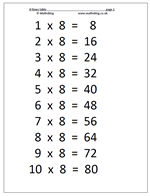 The 8 times table is another of the harder tables which many children never get a secure recall of. It is, of course, double the four times table and all the answers are even.
The 8 times table is another of the harder tables which many children never get a secure recall of. It is, of course, double the four times table and all the answers are even.
Remembering by doubling the four times table is OK but it never results in the really fast recall that comes with memorising the table.
The whole idea of tables is that they are learnt, off by heart. To do this it is essential to say them out loud:
One times eight is eight
two times eight is sixteen
three times eight is twenty four
four times eight is thirty two
five times eight is forty
six times eight is forty eight
seven times eight is fifty six
eight times eight is sixty four
nine times eight is seventy two
ten times eight is eighty
Later these can be shortened to say, for example, “ seven eights are fifty six”.
Below are two worksheets for the eight times table. A good way to do these is to time them to see how long your child takes.
Free maths worksheet: Standard written method for addition of two 3-digit numbers
 Free maths worksheet: Standard written method for addition of two 3-digit numbers.
Free maths worksheet: Standard written method for addition of two 3-digit numbers.
Addition of two 3-digit numbers is usually done on paper, using the following standard method.
The method is to add the units first, put the units in the answer, and ‘carry’ the ten into the tens column. Then add the tens and continue in the same way into the hundreds. Whilst all the questions on the free maths worksheet have carrying to both tens and hundreds, this will not always be necessary if the sum of the digits is less than 10.
To see each step in more detail, together with a page of questions and answers, view the pdf below:
Standard written addition of two 3-digit numbers
Learning tables: 7 times table
 Another of the harder tables, this time the 7 times table. Many people think this is the hardest of all as there is very little pattern to it and the answers cannot easily be worked out from knowledge of other tables.
Another of the harder tables, this time the 7 times table. Many people think this is the hardest of all as there is very little pattern to it and the answers cannot easily be worked out from knowledge of other tables.
Once again there is nothing especially ‘catchy’ to remember about this table, it is pretty much just hard work. It should not be learned until the 2, 3, 4, 5 and 10 times tables have been learned. If this has been achieved, then over half the 7 times table has already been mastered!
The whole idea of tables is that they are learned, off by heart. To do this it is essential to say them out loud:
One times seven is seven
two times seven is fourteen
three times seven is twenty one
four times seven is twenty eight
five times seven is thirty five
six times seven is forty two
seven times seven is forty nine
eight times seven is fifty six
nine times seven is sixty three
ten times seven is seventy
Below are two worksheets for the seven times table. A good way to do these is to time them to see how long your child takes.
When you get really good with a table you should be able to say it in under ten seconds (missing out unnecessary words ie one seven, seven; two sevens, fourteen…etc).
Learning tables: 6 times table
Now we come to some of the harder tables, starting with the 6 times table.
There is nothing especially ‘catchy’ to remember about this table, it is pretty much just hard work. It should not be learned until the 2, 3, 4, 5 and 10 times tables have been learned. If this has been achieved, then over half the 6 times table has already been mastered!
Someone with a good knowledge of the three times table can always double the answers to get the six! Also six sixes is thirty six has a nice rhythm to it. Continue reading “Learning tables: 6 times table”